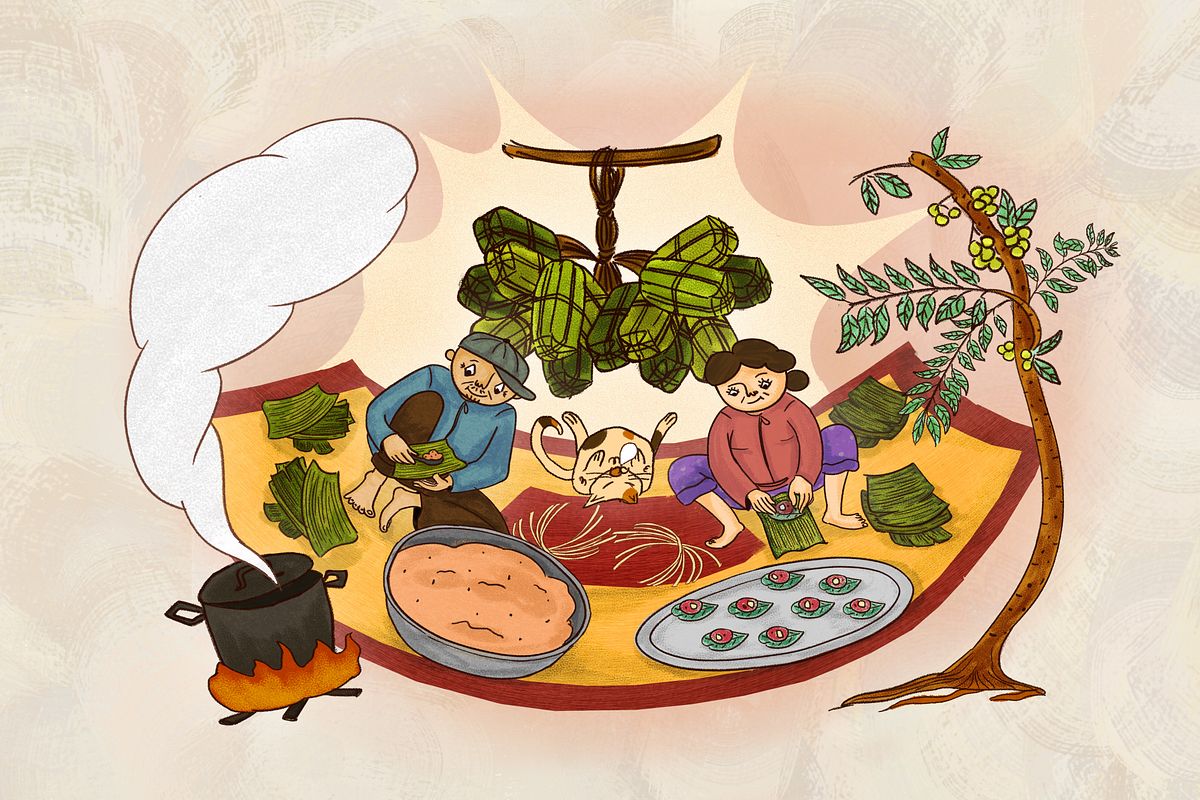During my journey to explore the culinary specialties of Khánh Hòa, I was delighted to discover the nem chua and chả lụa from Diên Khánh, a centuries-old ancient town that’s just 10 kilometers from downtown Nha Trang.
About 10 kilometers west from Nha Trang, there lies a historic citadel constructed by Nguyễn-era emperors during the early days of southward expansion to form the Bình Khang Prefecture under the control Hiền Lord (Nguyễn Phúc Tần). It’s called Diên Khánh Citadel, one of southern Vietnam’s oldest, and often referred to by locals as “the Citadel,” comprising the township in Diên Khánh Province today. Apart from historic structures, this is also the hometown of many traditional artisan villages, including nem chả — two rustic delicacies known simply as nem chả Thành (citadel nem chả).

Nem chả Diên Khánh is Khánh Hòa’s most notable treat.
Though both are processed meat sausages made of pork, nem is lightly fermented while chả is created by pulverizing the meat into a paste and then boiled. The first time I tasted this citadel nem chả, I could immediately detect the slight differences compared to similar versions from Huế or Đà Nẵng. This delightful personal experience, along with the affection both locals and tourists shower on this treat, compelled me to dig deeper into the making and culture behind nem chả.
The most crucial ingredient contributing to the quality of chả is, of course, freshly butchered pork. Contributing to the seasoning are flavorful locally made fish sauce made on the coast, and a little sweetness from sugar. With just a bite, one will immediately sense a savory mix of saltiness and sweetness, a faint tingliness from black pepper, and that special touch of banana leaves.

The corner where leaf-wrapped nem is boiled.
Compared to chả, nem is a much more complicated product involving more steps requiring a higher level of precision that not all manufacturers can attain to create that perfect bite of nem Thành. Only families who have been in the craft for decades could produce sausages with the right texture and that highly sought-after subtly sour taste.
Shredded pork skin, one of nem’s typical ingredients, must be cleaned properly to retain its bouncy texture without too much chew or odor. This is still a step that many nem makers do by hand to ensure it turns out up to the standard.



Nem chua Thành is first coated in a chùm ruột leaf before the final banana wrapping to promote fermentation.
The meat mixture is first coated in the leaves of chùm ruột, a berry native to Vietnam, to encourage natural fermentation and impart the subtle fragrance of the leaves. Then, each nugget is wrapped in banana leaves before being cooked. Some foodies enjoy eating the nem with the chùm ruột leaves, relishing the peppery notes of the leaves. Within the old citadel area, there's an entire village dedicated to making these sausages, each household has its own family recipe, but overall, a good nem should be lightly tangy in taste and a little leafy in smell without any off-putting smell. Some prefer their nem to be a little “young” — meaning freshly made and fermented for only 2–3 days, lightly chewy and meaty. Others wait until after the fifth day to enjoy nem, when the sourness reaches its prime and the pork skin is still bouncy. Older nem pieces might be too sour or start to go bad.



Wrapping chả from the meat paste.
Among the two dishes, perhaps chả Thành is more famous and respected as a local delicacy. The nem here might have its own fans that value the nuances in flavor, but most eaters might not be discerning enough to distinguish it from similar versions from nearby like Nha Trang and Ninh Hòa.
In contrast, chà Thành is a firmly established mainstay in the regional food landscape — not just as a savory snack to eat on its own, but also as a silent contributor to many other dishes like bánh căn, bánh xèo, bánh bèo, bún thịt nướng, etc. Step into an eatery in Diên Khánh or Nha Trang and you will immediately spot bundles of wrapped chả dangling in the display, their presence a sign of implicit trust by the vendors in the quality of their hometown’s special creation.

Freshly cooked chả is wrapped and tied into bundles, each comprising 14 pieces.
To enjoy the full-bodied flavors of chả, try slices of it with steaming bánh ướt. For nem, I would recommend grilling them on charcoal fire to bring out those vibrant notes of savoriness amid a chilly evening. A tip that I learned from locals involves biting a tiny bit of green chili and fresh garlic with nem chả — a stylish way to eat these Diên Khánh treats.
Nem chả from Diên Khánh remains rather obscure still; perhaps it can’t shine too brightly in the heart of Khánh Hòa’s already sparkling culinary sky. For me, both nem and chả carry the spirits of this coastal region.

Sweet chả and tangy nem.
If you happen to set foot in Khánh Hòa one day, the land where placid natural scenery harmonizes with historic cultural traditions, don’t hesitate to drop by Diên Khánh. Not only can you learn more about the history behind these moss-covered citadel walls, but also feast on bundles of tasty nem chả made using age-old methods.

















